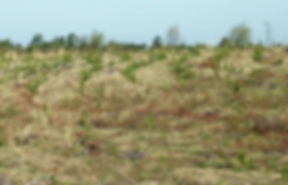
Jack Pine Planting Day 2024:
Let's plant 5,000 trees for KWs!
Registration will soon be open for Jack Pine Planting Day 2024. This year's event is set for May 4. Volunteers will be gathering at a site south of Four Mile Road and east of Beasley Avenue about six miles southeast of Grayling.
The goal this year is to plant 5,000
trees on four acres to create
new nesting habitat for Kirtland's
Warblers. This event is conducted in
partnership with Michigan United
Conservation Clubs, Huron Pines and
the Michigan Department of Natural
Resources. Our lead supporter is the
Saginaw Children's Zoo.
Volunteers will be gathering in an
area southeast of Four Mile Road and
east of Beasley Avenue at 9 a.m. to
fan out across the three acres. The
event will be held rain or shine
because we're on a strict schedule
-- these trees have to get into the
ground before the weather gets too
warm. Newly planted trees don't like
it if it gets too warm and dry before they've established their roots.
WE NEED YOUR HELP TO MAKE JPPD A SUCCESS
You can help us support Kirtand's Warbler conservation even if you
can't be in the field to plant trees. We've already sold the $1,000
event sponsorship but we are seeking sponsors at the Acre ($150) and
Quarter-Acre ($50) level. Your name or your business' name will appear
on our JPPD communications and will be included in thank you letters
to JPPD volunteers.
USE THIS QR CODE TO PURCHASE A SPONSORSHIP
or click HERE to visit our Donorbox form
Can't join us this year? We hope you will join us for Jack Pine Planting
Day in 2025. Make a note in your calendar now for Saturday, May 3.
We'll make registration information available in March.
Thank you!


The Jack Pine Ecosystem
This is the Jack Pine ecosystem that is the center of the Kirtland's Warbler historic range in Michigan's norther Lower Peninsula. More than 90 percent of Kirtland's Warblers' nests are in one small area of northern Michigan, some 70 miles from north to south and 90 miles from east to west.
There's not much here -- Jack Pine trees, of course, along with grasses, sedges, blueberries in the undergrowth and a few shrubs and trees. The soil in this ecosystem is sandy and nutrient poor, which severely limits what can grow.
Fire is historically has been a fundamental part of the ecology of the Kirtland’s Warbler’s ecosystem. The warbler and the other plants and animals in this area have not just adapted to fire, they have come to depend upon it. But no species in this ecosystem requires fire more than the Jack Pine. The Jack Pine's cones usually remain undamaged by the heat from a wildfire because fire moves through the tree so quickly. After the fire, the wind can disperse the winged seeds onto the ash-rich ground as far as 130 feet from the tree.
The Jack Pine is one of the most common trees in northern North America. A Jack Pine belt stretches across Canada from the Rockies to the Atlantic Ocean, and extends south into northern Michigan and as far north as Hudson Bay. The Jack Pine is able to live on the thin, acidic soil of the Canadian Shield, on rocky outcrops on mountainsides and in wet riverbeds. So with all these Jack Pines across North America, why does the Kirtland’s nest where it does? The answer is in the ground.
That’s because much of the soil here is composed of Grayling sand. The combination of low-hanging, overlapping branches of young Jack Pines with this sandy, well-draining soil that rarely floods is perfect for a bird that nests on the ground.
Today, this ecosystem is managed by both the U.S. Forest Service and the Michigan Department of Natural Resources. Through regular harvests and replanting, the agencies are creating new stands of young Jack Pines desirable to the Kirtland's Warblers.